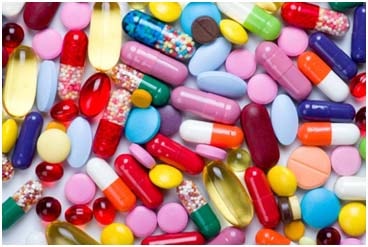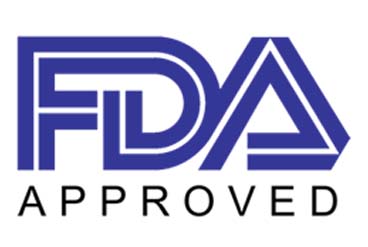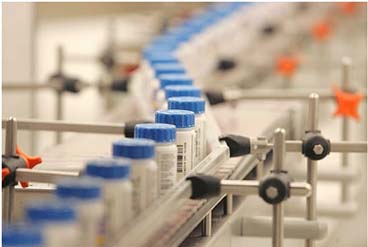The pharmaceutical and medicine manufacturing industry develops and produces a variety of medicinal and other health-related products that save the lives of millions of people from various diseases and permits many people suffering from illness to recover to lead productive lives.
- Thousands of medications are available today for diagnostic, preventive, and therapeutic uses. In addition to aiding in the treatment of infectious diseases such as pneumonia, tuberculosis, malaria, influenza, and sexually transmitted diseases, these medicines also help prevent and treat cardiovascular disease, asthma, diabetes, hepatitis, cystic fibrosis, and cancer. For example, anti-nausea drugs help cancer patients endure chemotherapy; clot-buster drugs help stroke patients avoid brain damage; and psychoactive drugs reduce the severity of mental illness for many people. Antibiotics and vaccines have dramatically reduced the occurrences of such diseases as diphtheria, syphilis, and whooping cough. Discoveries in veterinary drugs have controlled various diseases, some of which are transmissible to humans
- The pharmaceutical industry worlwide has achieved worldwide prominence through research and development (R&D) on new drugs, and spends a relatively high proportion of its revenue on R&D compared with other industries. Each year, pharmaceutical industry testing involves millions of compounds, yet may eventually yield fewer than 100 new prescription medicines
- For the majority of firms in this industry, the actual manufacture of drugs is the last stage in a lengthy process that begins with scientific research to discover new products and to improve or modify existing ones. The R&D departments in pharmaceutical and medicine manufacturing firms start this process by seeking and rapidly testing libraries of thousands to millions of new chemical compounds with the potential to prevent, combat, or alleviate symptoms of diseases or other health problems. Scientists use sophisticated techniques, including computer simulation, combinatorial chemistry, and high-throughput screening (HTS), to hasten and simplify the discovery of potentially useful new compounds
- Most firms devote a substantial portion of their R&D budgets to applied research, using scientific knowledge to develop a drug targeted to a specific use. For example, an R&D unit may focus on developing a compound that will effectively slow the advance of breast cancer. If the discovery phase yields promising compounds, technical teams then attempt to develop a safe and effective product based on the discoveries.
- To test new products in development, a research method called "screening" is used. To screen an antibiotic, for example, a sample is first placed in a bacterial culture. If the antibiotic is effective, it is next tested on infected laboratory animals. Laboratory animals also are used to study the safety and efficacy of the new drug. A new drug is selected for testing on humans only if it either promises to have therapeutic advantages over drugs already in use or is safer. Drug screening is a laborious and costly process—only 1 in every 5,000 to 10,000 compounds screened eventually becomes an approved drug
- After laboratory screening, firms conduct clinical investigations, or "trials," of the drug on human patients. Human clinical trials normally take place in three phases. First, medical scientists administer the drug to a small group of healthy volunteers to determine and adjust dosage levels, and monitor for side effects. If a drug appears useful and safe, additional tests are conducted in two more phases, each phase using a successively larger group of volunteers or carefully selected patients. The final round of testing often involves a very large panel, sometimes upwards of 10,000 individuals
- After a drug successfully passes animal and clinical tests, the Food and Drug Administration's (FDA) Center for Drug Evaluation and Research (CDER) must review the drug's performance on human patients before approving the substance for commercial use. The entire process, from the first discovery of a promising new compound to FDA approval, can take over a decade and cost hundreds of millions of dollars
- After FDA approval, problems of production methods and costs must be worked out before manufacturing begins. If the original laboratory process of preparing and compounding the ingredients is complex and too expensive, pharmacists, chemists, chemical engineers, packaging engineers, and production specialists are assigned to develop a manufacturing process economically adaptable to mass production. After the drug is marketed, new production methods may be developed to incorporate new technology or to transfer the manufacturing operation to a new production site
- Most pharmaceutical production plants are highly automated. Milling and micronizing machines, which pulverize substances into extremely fine particles, are used to reduce bulk chemicals to the required size. These finished chemicals are combined and processed further in mixing machines. The mixed ingredients may then be mechanically capsulated, pressed into tablets, or made into solutions. One type of machine, for example, automatically fills, seals, and stamps capsules. Other machines fill bottles with capsules, tablets, or liquids, and seal, label, and package the bottles
- Quality control and quality assurance are vital in this industry. Many production workers are assigned full time to quality control and quality assurance functions, whereas other employees may devote part of their time to these functions. For example, although pharmaceutical company sales representatives, often called detailers, work primarily in marketing, they engage in quality control when they assist pharmacists in checking for outdated products
- The pharmaceutical and medicine manufacturing industry consists of over 2,500 places of employment, located throughout the country. R&D laboratories perform the work of drug discovery and development, while manufacturing plants produce the final drugs for consumers. Most R&D laboratories are located separately from manufacturing plants, but some labs and production plants are integrated
- There are three main types of pharmaceutical companies. Large, or mainline, pharmaceutical companies are established firms that have many approved drugs already on the market. These companies often have significant numbers of R&D laboratories and manufacturing plants throughout the Nation and around the world. In contrast, smaller pharmaceutical companies are usually newer firms that often do not have any approved drugs on the market. As a result, these firms almost exclusively perform R&D. In addition to developing their own drugs, some small pharmaceutical companies perform contract research for other pharmaceutical companies. Finally, generic pharmaceutical companies manufacture drugs that are no longer protected by patents. Because their products are all established drugs, they devote fewer resources to R&D and more to manufacturing
- Advances in biotechnology are transforming drug discovery and development. Bioinformatics, a branch of biotechnology using information technologies to work with biological data like DNA, is a particularly dynamic new area of work. Scientists have learned a great deal about human genes, but the real work—translating that knowledge into viable new drugs—have only recently begun. So far, millions of people have benefited from medicines and vaccines developed through biotechnology, and several hundred new biotechnologically-derived medicines are currently in the pipeline. These new medicines, all of which are in human clinical trials or awaiting FDA approval, include drugs for cancer, infectious diseases, autoimmune diseases, neurologic disorders, and HIV/AIDS
- Many new drugs are expected to be developed in the coming years. Advances in technology and the knowledge of how cells work will allow pharmaceutical and medicine manufacturing makers to become more efficient in the drug discovery process. New technology allows life scientists to test millions of drug candidates far more rapidly than in the past. Other new technology, such as regenerative therapy, also will allow the natural healing process to work faster, or enable the regrowth of missing or damaged tissue. In addition, technology based on the study of genes is being explored to develop vaccines to prevent or treat diseases that have eluded traditional vaccines, such as AIDS, malaria, tuberculosis, and cervical cancer
- Advances in manufacturing processes are also impacting the industry. While pharmaceutical manufacturers have long devoted resources to new drug development as a source for future profits, firms are increasingly realizing that improvements throughout the drug pipeline are needed to stay competitive. Along with other manufacturing industries, pharmaceutical manufacturers are realizing that quality products can best be produced when quality improvements occur at all stages and when processes are continually updated with the latest technologies and methods. Controlling the product flow through the supply chain also ensures that valuable resources do not sit idle but are put to work, and that final products reach consumers without delay









